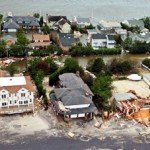The Intergovernmental Panel on Climate Change (IPCC) calculated projected temperature changes for various scenarios in 2007 and researchers at the Max Planck Institute for Meteorology in Hamburg have now gone one step further: they have developed a new model that specifies the maximum volumes of carbon dioxide that humans may emit to remain below the critical threshold for climate warming of two degrees Celsius. To do this, the scientists incorporated into their calculations data relating to the carbon cycle, namely the volume of carbon dioxide absorbed and released by the oceans and forests. The aim of the international ENSEMBLES project is to simulate future changes in the global climate and carbon dioxide emissions and thereby to obtain more reliable threshold values on this basis. (Climatic Change, July 21, 2010)

Figure: Evolution of the carbon dioxide emissions calculated by the model (left) and the temporal development of the global mean annual temperature (right). In order to achieve the long-term stabilisation of the atmospheric carbon dioxide concentration, fossil carbon dioxide emissions must be reduced to around zero by the end of the century. The black lines represent the observed values. (GtC/year = gigatons carbon/year)
(Image: Max Planck Institute for Meteorology)
The concentration of carbon dioxide in the atmosphere caused by the combustion of fossil fuels (gas, oil) has increased by around 35 percent since the beginning of the Industrial Revolution. If carbon dioxide emissions and, as a result, atmospheric carbon dioxide concentrations continue to increase unchecked, a drastic increase in the global temperature can be expected before the end of this century. With the help of new models for a prescribed atmospheric carbon dioxide concentration, scientists from all over Europe have now calculated for the first time the extent to which the global carbon dioxide emissions must be reduced to halt global warming.
“What’s new about this research is that we have integrated the carbon cycle into our model to obtain the emissions data,” says Erich Roeckner. According to the model, admissible carbon dioxide emissions will increase from approximately seven billion tonnes of carbon in the year 2000 to a maximum value of around ten billion tonnes in 2015. In order to achieve the long-term stabilization of the atmospheric carbon dioxide concentration, the emissions will then have to be reduced by 56 percent by the year 2050 and approach zero towards the end of this century. Although, based on these calculations, global warming would remain under the two-degree threshold until 2100, further warming may be expected in the long term. “It will take centuries for the global climate system to stabilize,” says Erich Roeckner.
The scientists used a new method with which they reconstructed historical emission pathways on the basis of already-calculated carbon dioxide concentrations. To do this, Erich Roeckner and his team adopted the methodology proposed by the International Panel on Climate Change (IPCC) for simulations being carried out for the future Fifth IPCC Assessment Report: earth system models that incorporate the carbon cycle were used to estimate the anthropogenic carbon dioxide emissions that are compatible with a prescribed concentration pathway. In this case, the emissions depend solely on the proportion of the anthropogenic carbon in the model that is absorbed by the land surface and the oceans. Repetition of the experiments using different pre-industrial starting dates enabled the scientists to distinguish between anthropogenic climate change and internal climate variability.
The model used for this study is based on a low-resolution spatial grid with a grid spacing of around 400 kilometres, which takes the atmosphere, plus the land surface, the ocean, including sea ice, and the marine and terrestrial carbon cycle into account.
The overall aim of the study is to simulate future changes in the climate and carbon dioxide emissions in a single scenario in which the carbon dioxide equivalent concentrations in the atmosphere are stabilized in the long term at 450 parts per million (ppm), so that global warming increases to a maximum of two degrees above the pre-industrial level. The data are currently being evaluated by other European climate centres. “As soon as all of the results are available, we can evaluate the spread between the models,” says Erich Roeckner. “The more significant the data we have, the more accurate our forecast will be.”
Original Work:
Erich Roeckner, Marco A. Giorgetta, Traute Crueger, Monika Esch, Julia Pongratz
“Historical and Future Anthropogenic Emission Pathways Derived from Coupled Climate-Carbon Cycle Simulations”
Climatic Change, DOI 10.1007/s10584-010-9886-6, (2010)
For more details, check the website of the ENSEMBLES Project.

About Max Planck Society for the Advancement of Science
The Max Planck Society for the Advancement of Science is an independent, non-profit research organization located in Munich, Germany, that primarily promotes and supports research at its own institutes. It was founded on February 26, 1948, and is the successor organization to the Kaiser Wilhelm Society for the Advancement of Science.
The research institutes of the Max Planck Society perform basic research in the interest of the general public in the natural sciences, life sciences, social sciences, and the humanities. In particular, the Max Planck Society takes up new and innovative research areas that German universities are not in a position to accommodate or deal with adequately.
For more details, visit www.mpg.de
Source: Max Planck Society Press Release dated August 2, 2010.












